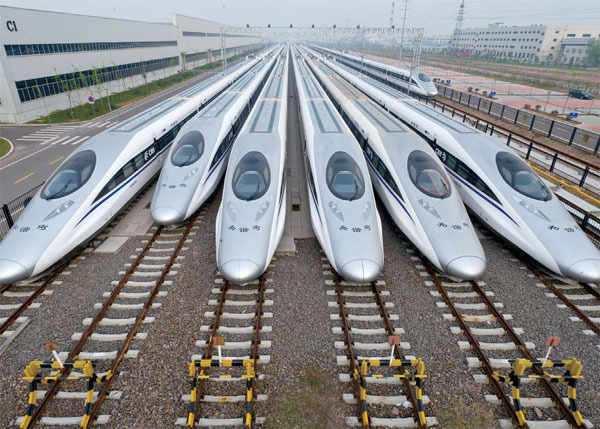Bullet trains making tracks across national borders
Chinese companies prepare to modernize rail systems globally with competitive prices, advanced technology, prompt delivery and financing
The capacity to manufacture and export top-end high-speed trains and related equipment is giving a new sheen to China's image.
Foreign governments and corporate clients are sitting up and taking notice.
|
High-speed train CRH380A lined up at Qingdao, Shandong province. Provided to China Daily |
China is in talks with more than 30 countries, including the United States, Russia, Brazil, Thailand, Turkey, Saudi Arabia and Iran about high-speed rail projects, says Wang Mengshu, a deputy to the National People's Congress and deputy chief engineer of China Railway Tunnel Group Ltd.
"China's first high-speed rail project in Indonesia will spur the interest of more countries that are keen to put their economic growth on a firmer footing through efficient transportation systems and regional connectivity," Wang says.
China was selected last year by the Indonesian government to build the nation's first bullet rail link - the $5.5 billion, 150-kilometer Jakarta-Bandung route.
With the operational date set for 2019, the project will be developed by PT Kereta Cepat Indonesia-China, a joint venture between a consortium of Indonesian state-owned companies and China Railway International Co Ltd, a subsidiary of China Railway Corp Group. China Development Bank will provide around 75 percent of the funding with the rest arranged by the joint venture partners.
"Even though China is a latecomer to the field in comparison with its German and French rivals, its rail equipment companies have thrived thanks to cost advantages, reasonable delivery times and flexible financing models," Wang says.
Eager to compete with established rivals in Europe, Japan and Canada, China will further develop "smart trains", which apply intelligent technology that will allow digital speed control, condition determination and fault detection, Wang says.
The Chinese government announced in September a 370-kilometer high-speed rail project between Las Vegas and Los Angeles will be built by a joint venture with Chinese rail companies, including China Railway Construction Corp, China Railway Corp, and XpressWest Enterprises, a US passenger rail service provider. The estimated cost of the project is $12.7 billion.
As a result, China Railway Rolling Stock Corp, the country's largest train manufacturer, plans to deploy more resources and manpower in the global high-speed rail equipment market, especially in developed economies such as the US or the United Kingdom, to fuel robust growth in the next decade.
The entire range of CRRC's products, including diesel locomotives, electric multiple units and light-rail vehicles, has been exported to nearly 100 countries and regions.
Yu says the company's next step is to gradually switch focus from product exports to capital and technology exports globally.
CRRC is preparing to export bullet trains for a high-speed rail project in Russia that would connect Moscow to Kazan. It is expected to run 770 km through seven Russian regions with a total population of over 25 million.
The Chinese company has 46 wholly owned or holding subsidiaries and more than 170,000 employees. It has already built manufacturing facilities and maintenance centers in Malaysia, Turkey and Brazil.
Sheng Guangzu, a deputy to the National People's Congress and general manager of China Railway Corp, the country's railway service provider, says the Belt and Road Initiative will help China export more high-speed rail technologies and related products. The initiative connects Asia, Europe and Africa and passes through more than 60 countries and regions.
A Chinese consortium led by Third Railway Survey and Design Institute Group Corp was also chosen to conduct the feasibility study on a planned New Delhi-Mumbai rail project, a big step forward to the development of the Indian rail market.
China exported railway equipment worth 21 billion yuan ($3.2 billion; 2.9 billion euros) between January and October of last year, up 36 percent year-on-year, according to the latest figures released by the National Bureau of Statistics.
Contact the writers at zhongnan@chinadaily.com.cn and xiechuanjiao@chinadaily.com.cn



















